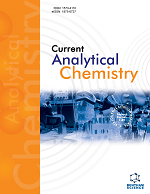- Home
- A-Z Publications
- Current Analytical Chemistry
- Previous Issues
- Volume 19, Issue 6, 2023
Current Analytical Chemistry - Volume 19, Issue 6, 2023
Volume 19, Issue 6, 2023
-
-
Prediction of Toxicity of Nanomaterials Using QSAR Approach
More LessAuthors: Dilpreet Singh and Pooja A. ChawlaBuilding mathematical models based on the analysis of physiochemical systems is known as computational modeling. It may be used to combine different types of data and gain a thorough grasp of how they are correlated. Computational modeling techniques cannot replace true experimental techniques or function as a real mechanism. Despite this, they showed to be highly effective at displaying the outcomes fo Read More
-
-
-
Electrochemical Analysis of Narcotic Drugs Using Nanomaterials Modified Electrodes – A Review
More LessAuthors: Ramila D. Nagarajan, J. Kavitha, Raji Atchudan, Sandeep Arya and Ashok K. SundramoorthyThe usage of abused illicit drugs remains an increasing challenge for drug regulatory authorities and therefore, it is important to develop advanced sensor technology that able to identify and determine drugs concentration in seized samples, biological fluids and food samples. The World Health Organization (WHO) recommends the usage of narcotic drugs legally for the medical treatments. Thus, many reports indicated that the Read More
-
-
-
Caffeine Electrochemical Sensor Constructed by Graphene Oxide and Reduced Graphene Oxide: A Mini-review
More LessBy Gan YangIt is very important to determine the concentration of target substances in food safety, environmental detection, and drug supervision. Caffeine, a natural alkaloid, is widely found in various drinks and drugs. In addition to its beneficial functions, caffeine also has certain negative effects. Therefore, it is very important to determine the concentration of caffeine in drugs, beverages, wastewater, and other media. Among va Read More
-
-
-
A Case Study on Bacteriological and Physiochemical Evaluation of Hospitals Drinking Water in Pakistan
More LessBackground: Seventy percent of the Earth is covered by water, out of which only 1% is fresh water. This fresh water can be used for drinking and other domestic uses. However, a drastic increase in the industrial revolution resulted in depletion of the reservoirs and contamination of the potable fresh water. Around 3.4 M deaths per annum occur as a result of waterborne diseases. Objectives: Therefore, the aim of this stu Read More
-
-
-
Determination of Cyanide at Trace Levels by Computational Scanning Densitometry
More LessIntroduction: Cyanide is one of the most commonly present anions in industrial effluents, highly toxic to human and animal life. Therefore, its determination in aqueous media by simple, portable, and quick methods is required. Objective: This study aims to develop a simple and quick method to determine this anion at the micro level in aqueous media without using any expensive instrument. Method: The method is ba Read More
-
-
-
Use of Fe3O4@MPTMS-Dithizone Magnetic Nanoparticles as Solid Phase Sorbent for Sensitive Analysis of Sibutramine Molecules in Herbal Slimming Products
More LessAuthors: Özge Demir, Halil Ìbrahim Ulusoy, Ümmügülsüm Polat and Songül UlusoyBackground: A new enrichment and sensitive determination method, which includes HPLCDAD analysis after Magnetic Solid Phase Extraction (MSPE), has been developed for trace analysis of Sibutramine molecules in herbal slimming products. Sibutramine is one of the most adulterated drug molecules in herbal products. Method: In the proposed method, Sibutramine molecules were pre-concentrated by using Fe3O4@M Read More
-
-
-
Synthesis and Chiral Separation of Some New Derivatives of Imidazo [1, 2-a] Pyridine
More LessIntroduction: Mannich base is the result of the three-part chemical reaction known as the Mannich reaction, which includes the amino alkylation of an acidic proton adjacent to a carbonyl group by formaldehyde and either a primary or secondary amine. Method: In a 1L flask, dissolve 28.2 g (0.3 mol) of 2-aminopyridine, and 400 mL of ethanol, then add 32.6 g (0.3 mol) of chloroacetone and put 30 drops of acetic acid. The organi Read More
-
-
-
Degradation of LDPE Using the Winogradsky Column Containing Otteri Dumpsite Soil: Prediction of Mechanism and Metabolites Determination
More LessBackground: Plastic pollution has taken over the world. Toxicity of the plastics and other pollutants is enhanced due to the formation of microplastics and nano-plastics that attract Persistent Organic Pollutants (POPs). The need for the treatment of plastic waste in the current scenario led to the rise of various treatment processes. Biodegradation, an eco-friendly approach to eliminate plastics urged to discover plastic-u Read More
-
-
-
Stability Indicating Analytical Method, Characterization of Degradation Impurity by UPLC-Q-TOF-MS/MS, and Establishment of Degradation Mechanism of Evodiamine
More LessAuthors: Daya R. Adye, Amit Kumar Sahu, Niraj Rajput, Niraj Kumar Panday and Pinaki SenguptaAim: The current research aims to establish a stability-indicating analytical method (SIAM) for the quantification of evodiamine (EVO), characterization of its degradation impurity, and establishment of possible degradation pathways. Background: None of the degradation impurities of EVO is known and the mechanism of their formation has not been reported in any literature to date. Moreover, a SIAM for EVO is not Read More
-
Volumes & issues
-
Volume 21 (2025)
-
Volume 20 (2024)
-
Volume 19 (2023)
-
Volume 18 (2022)
-
Volume 17 (2021)
-
Volume 16 (2020)
-
Volume 15 (2019)
-
Volume 14 (2018)
-
Volume 13 (2017)
-
Volume 12 (2016)
-
Volume 11 (2015)
-
Volume 10 (2014)
-
Volume 9 (2013)
-
Volume 8 (2012)
-
Volume 7 (2011)
-
Volume 6 (2010)
-
Volume 5 (2009)
-
Volume 4 (2008)
-
Volume 3 (2007)
-
Volume 2 (2006)
-
Volume 1 (2005)
Most Read This Month
Article
content/journals/cac
Journal
10
5
false
en


